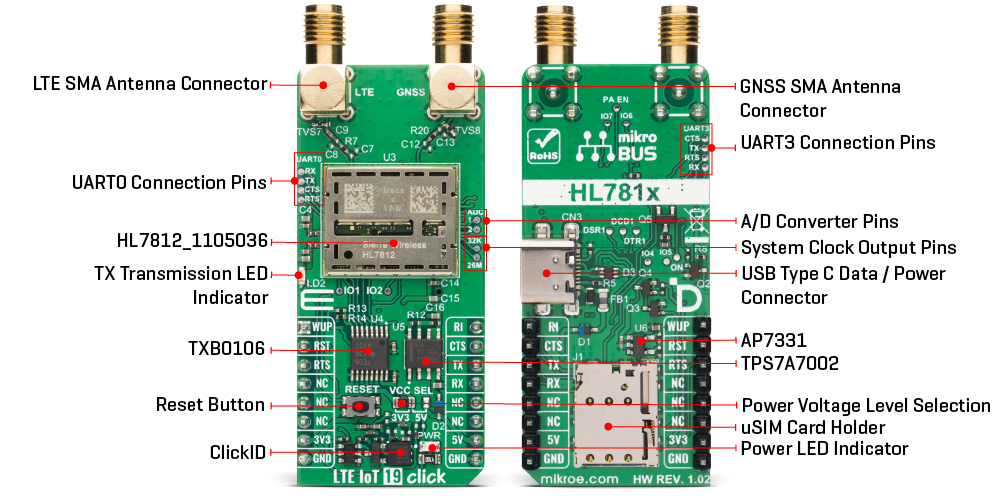OFF
GO LOCAL
| Company | Stock | Price |
|---|---|---|

MIKROE-6803
26 g
Status:
LTE IoT 19 Click is a compact add-on board designed to provide low-power, long-range cellular connectivity for embedded applications, enabling LTE-M, NB-IoT, and 2G fallback for reliable communication in industrial and mission-critical IoT deployments. It is based on the HL7812 LTE-M and NB-IoT module from Semtech ultra-low power consumption, high transmit power, and deep coverage for battery-powered or remote devices. This Click board™ integrates advanced RF performance across 850/900/1800/1900MHz bands, built-in GNSS (GPS and GLONASS) for positioning, Power Save Mode, eDRX, Release Assistance Indication, and flexible manual or dynamic system selection across RATs. LTE IoT 19 Click is ideal for asset tracking, smart metering, smart city infrastructure, remote monitoring, and other IoT applications requiring secure and future-proof cellular connectivity.
LTE IoT 19 Click is fully compatible with the mikroBUS™ socket and can be used on any host system supporting the mikroBUS™ standard. It comes with the mikroSDK open-source libraries, offering unparalleled flexibility for evaluation and customization. What sets this Click board™ apart is the groundbreaking ClickID feature, enabling your host system to automatically detect and identify this add-on board.
This product is no longer in stock
Availability date:
OFF
| Company | Stock | Price |
|---|---|---|

LTE IoT 19 Click is based on the HL7812, a global Low Power Wide Area (LPWA) cellular module from Semtech that combines LTE-M, NB-IoT, and 2G fallback designed for industrial and mission-critical IoT. This module delivers best-in-class power consumption, high transmit power, and deep coverage for remote or battery-powered deployments, meeting 3GPP Release 14 requirements and ensuring future-proof connectivity for long-lived field devices. By integrating support for LTE Cat-M1 and Cat-NB2 together with quad-band 2G GPRS, the HL7812 offers connectivity across different radio access technologies with flexible manual or dynamic system selection, enabling reliable operation even in challenging environments. Its industry-leading security from the edge to the cloud, and extended coverage features like Power Save Mode, extended Discontinuous Reception (eDRX), and Release Assistance Indication make it ideal for asset tracking, smart metering, smart city infrastructure, and any application where energy efficiency, robust connectivity, and longevity are paramount.

The HL7812 integrates advanced RF and protocol capabilities that maximize performance and versatility. It provides high transmit power across 850/900/1800/1900MHz for 2G and Class 3 (23dBm) operation for both Cat-M1 and Cat-NB2, ensuring strong links even at cell edges. LTE Cat-M1 supports uplink speeds up to 1100kbit/s and downlink up to 590kbit/s, while Cat-NB2 supports up to 158kbit/s uplink and 127kbit/s downlink, all with 3GPP Rel.14 features like HARQ-ACK bundling, multiple HARQ processes, and Control Plane CIoT optimization. The module also incorporates built-in GNSS (GPS and GLONASS) for precise positioning and tracking, plus features like NIDD over SCEF/SGi tunneling, idle and connected mobility, and operational modes for in-band, guard band, or standalone deployments.
Communication between the HL7812 and the host MCU is made through a UART interface, using standard UART RX and TX pins and hardware flow control pins (CTS/RTS/RI - Clear to Send/Ready to Send/Ring Indicator) for efficient data transfer. The module defaults to a communication speed of 115200bps, allowing for data exchange over AT commands. This Click board™ also includes a USB Type C connector for both power and data transfer, compliant with the USB 2.0 specification. The board also includes several additional functionalities that enhance its usability and control.
The RESET button allows users to easily reset the module. This function can also be controlled digitally via the mikroBUS™ RST pin, offering greater flexibility. In addition to the primary UART interface used for standard data communication, the board provides dedicated pins for a debug UART (UART0), which is intended for firmware debugging and upgrading. It further includes an auxiliary UART (UART3) that allows flexible use of AT command communication and data transmission, giving developers extended control and connectivity options within their applications.
The board features SMA connectors for LTE antenna (LTE Flat Rotation Antenna) and one for GNSS such as the GPS Passive Antenna offered by MIKROE, ensuring efficient connectivity options. The board also has a micro SIM card holder that supports both 1.8V and 3V uSIM cards, allowing users to select the most appropriate service provider for their particular use case, and one blue LED indicator for TX activity indication. There is also a set of test points labeled ADC, providing access to the HL7812 module’s 12-bit resolution analog-to-digital converter channels with a voltage range of 0–1.8 V for monitoring external signals, as well as 32K and 26M test points which expose two digital clock output signals for timing or diagnostic purposes.
This Click board™ can operate with both 3.3V and 5V logic voltage levels selected via the VCC SEL jumper. Since the HL7812 module operates at 4.07V and communicates at 1.8V, a logic-level translator, the TXB0106 is also used for proper operation and an accurate signal-level translation. This way, both 3.3V and 5V capable MCUs can use the communication lines properly. Also, this Click board™ comes equipped with a library containing easy-to-use functions and an example code that can be used as a reference for further development.
Type
GPS/GNSS,LTE IoT
Applications
Ideal for asset tracking, smart metering, smart city infrastructure, remote monitoring, and other IoT applications requiring secure and future-proof cellular connectivity
On-board modules
HL7812 - LTE-M and NB-IoT Module for industrial IoT from Semtech
Key Features
Advanced RF performance, support for LTE-M, NB-IoT and 2G fallback, ultra-low power consumption, extended Discontinuous Reception, Release Assistance Indication, built-in GNSS with GPS and GLONASS for positioning and tracking, manual or dynamic system selection across radio access technologies, UART communication with hardware flow control, USB Type-C connector for power and data transfer, and more
Interface
UART
Feature
ClickID
Compatibility
mikroBUS™
Click board size
L (57.15 x 25.4 mm)
Input Voltage
3.3V or 5V
This table shows how the pinout on LTE IoT 19 Click corresponds to the pinout on the mikroBUS™ socket (the latter shown in the two middle columns).
| Label | Name | Default | Description |
|---|---|---|---|
| LD1 | PWR | - | Power LED Indicator |
| LD2 | LD2 | - | TX Transmission LED Indicator |
| JP1 | VCC SEL | Left | Power Voltage Level Selection 3V3/5V: Left position 3V3, Right position 5V |
| T1 | RESET | - | Reset Button |
| Description | Min | Typ | Max | Unit |
|---|---|---|---|---|
| Supply Voltage | 3.3 | - | 5 | V |
| LTE Frequencies | 850/900/1800/1900 | MHz | ||
| GNSS Frequencies | 1575.42 | - | 1605.38 | MHz |
| Transmit Power (LTE Cat-M1 & Cat-NB2) | - | 23 | - | dBm |
LTE IoT 19 Click demo application is developed using the NECTO Studio, ensuring compatibility with mikroSDK's open-source libraries and tools. Designed for plug-and-play implementation and testing, the demo is fully compatible with all development, starter, and mikromedia boards featuring a mikroBUS™ socket.
Example Description
Application example shows device capability of connecting to the network and sending SMS or TCP/UDP messages or retrieving data from GNSS using standard "AT" commands.
Key Functions
lteiot19_cfg_setup This function initializes Click configuration structure to initial values.lteiot19_init This function initializes all necessary pins and peripherals used for this Click board.lteiot19_set_sim_apn This function sets APN for sim card.lteiot19_send_sms_text This function sends text message to a phone number.lteiot19_cmd_run This function sends a specified command to the Click module.Application Init
Initializes the driver and logger.
Application Task
Application task is split in few stages:
Powers up the device, performs a factory reset and reads system information.
Sets configuration to device to be able to connect to the network (used only for SMS or TCP/UDP demo examples).
Waits for the network registration indicated via CEREG command and then checks the signal quality report (used only for SMS or TCP/UDP demo examples).
Configures device for the selected example.
Depending on the selected demo example, it sends an SMS message (in PDU or TXT mode) or TCP/UDP message, or waits for the GPS fix to retrieve location info from GNSS. By default, the TCP/UDP example is selected.
Application Output
This Click board can be interfaced and monitored in two ways:
Additional Notes and Information
The complete application code and a ready-to-use project are available through the NECTO Studio Package Manager for direct installation in the NECTO Studio. The application code can also be found on the MIKROE GitHub account.
NOTE: Please be advised that any peripheral devices or accessories shown connected to the Click board™ are not included in the package. Check their availability in our shop or in the YMAN section below.